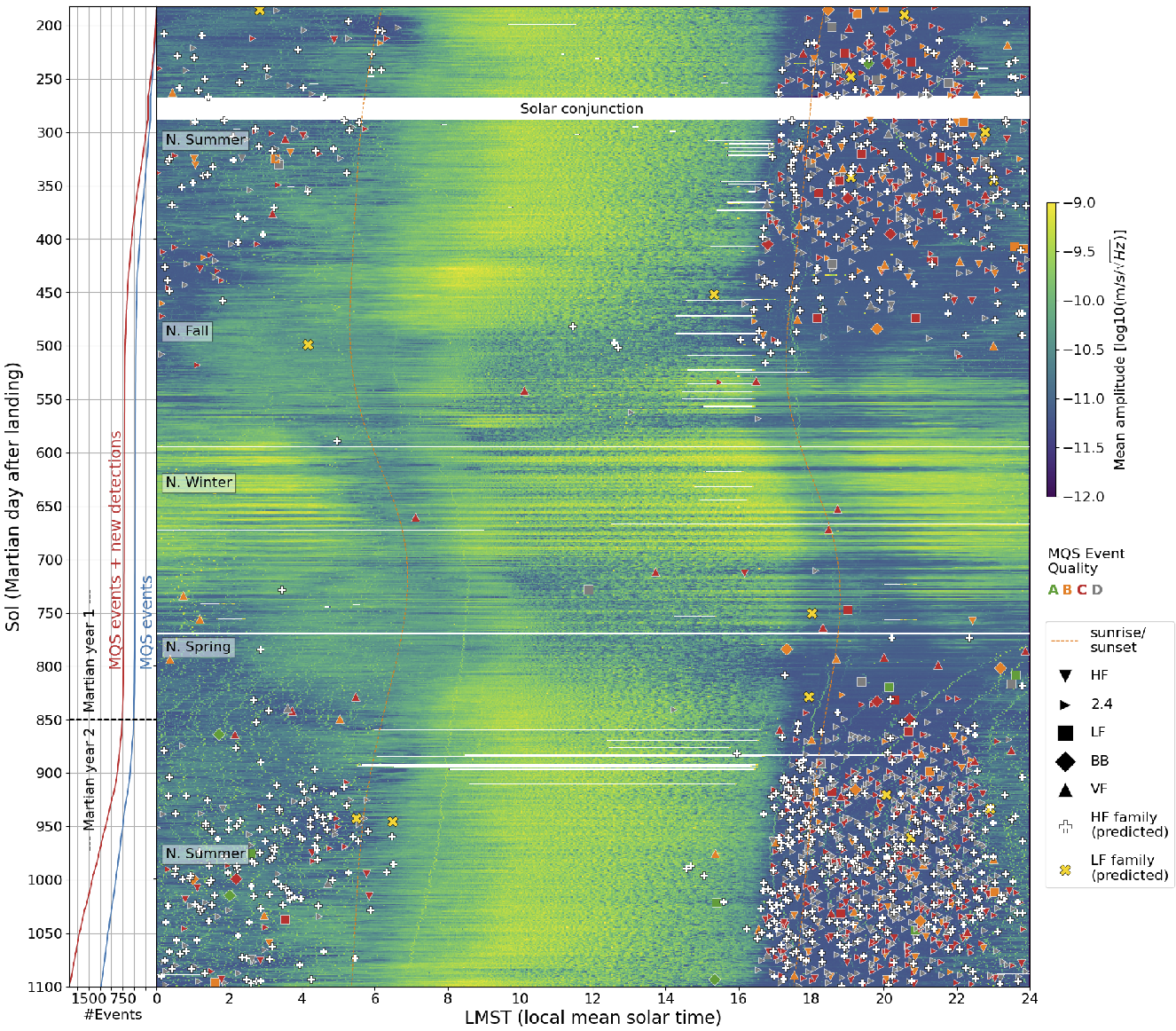A Deep Marsquake Catalogue
- 1Institute of Geopysics, Department of Earth Sciences, ETH Zurich, Switzerland
- 2Swiss Seismological Service, ETH Zurich, Zurich, Switzerland
- 3Institut Supérieur de l'Aéronautique et de l'Espace, Toulouse, France
InSight seismic data and marsquake catalogue
NASA's InSight seismometer has been recording the seismicity of Mars for over 3 years and to date, over 1300 seismic events were found by the Marsquake Service (MQS) [1,2]. Marsquakes usually have a low signal-to-noise ratio (SNR) and are consequently often hidden or contaminated by the background noise, making their detection and analysis challenging. Local winds interact with the lander and seismometer system and generate noise levels that fluctuate throughout the Martian day and regularly exceed typical event amplitudes. Additionally, extreme temperature changes cause transient high-amplitude spikes [3]. Conventional tools, such as the STA/LTA detectors, perform poorly on this dataset, as the various noise signals often share a common bandwidth and can be similar in duration to marsquakes [3]. Therefore, MQS detects events by manual data review and discriminates them from wind noise [4] by comparing the seismic data to onboard wind measurements if available, or otherwise, to the excitation of wind-driven lander modes. MQS classifies events by their frequency content into low- (<10%) and high-frequency (>90%) event families and assigns a quality based on their locatability (A: highest to D: lowest quality) [1].
Marsquake detection with convolutional neural network
Deep learning methods, and in particular convolutional neural networks (ConvNet) are nowadays routinely used for complex tasks such as speech or visual object recognition [5]. Here, we use a ConvNet architecture designed for image segmentation [6] to detect marsquake energy in the time-frequency domain. We train the ConvNet to predict segmentation masks that pixel-wise identify event and noise energy based on the time-frequency representation of a given waveform. We use the method to detect marsquakes and to decompose their signal in event and noise components. This allows us to estimate the marsquake duration, frequency content, and SNR. We use the ConvNet to extend the MQS catalogue and further highlight its value in removing noise contamination from marsquakes [7]. Since the MQS catalogue is much smaller than typically labelled datasets used in deep learning [7], we create a training set with synthetic events with stochastic waveform modelling [8]. Synthetic events mimic the different MQS event types in terms of frequency content and duration and are combined with recorded InSight noise to include all types of noise.
Results
We run our ConvNet-based detector on the complete 20 samples-per-second dataset (over 900 Martian days) and compare our results to the careful manually curated MQS catalogue: we can detect all high-quality events and the majority of low-quality events - in addition to these, we find many additional low SNR events. We extend the catalogue by ~50% more events, of which the majority belongs to the high-frequency event family. An overview of the MQS events and our new detections is given in Figure 1. Similar to the MQS catalogue, we find many events in the quiet evening periods during the spring and summer of the Martian year 1 and 2, and further increase the number of events during the nights when noise levels are elevated. During the high noise periods (day time and winter), when noise amplitudes are orders of magnitudes above typical event amplitudes, we do not confidently detect events apart from a few that fall into short quieter periods. Our results suggest that the MQS catalogue is essentially complete for high SNR events and further support previous findings [9] on the seasonality of high-frequency events and their increased activity in Martian year 2 compared to year 1.

Figure 1: Overview of seismic noise, catalogued MQS events and new detections from ConvNet: the background of the main figure represents the broadband, vertical component seismic noise level (data gaps shown in white). The symbols indicate different event types belonging to the low frequency (LF, BB) or high frequency family (2.4, HF, VF), and colours indicate the qualities in the MQS catalogue; new detections found with our ConvNet detector are shown with their predicted event family type. The panel on the left side shows the cumulative event count using MQS events (blue) and MQS events and new detections (red). The event numbers are dominated by the high frequency events (corresponding to over 90% of events).
References:
[1] Clinton et al. (2021), 10.1016/j.pepi.2020.106595
[2] InSight Marsquake Service (2022), doi.org/10.12686/a16
[3] Ceylan et al. (2021), 10.1016/j.pepi.2020.106597
[4] Charalambous et al. (2021) 10.1029/2020JE006538
[5] LeCun et al. (2015), 10.1038/nature14539
[6] Ronneberger et al. (2015), 10.1007/978-3-319-24574-4_28
[7] Zhu et al. (2019), 10.1109/TGRS.2019.2926772
[8] Boore (2003), 10.1007/PL00012553
[9] Knapmeyer et al. 10.1016/j.epsl.2021.117171
How to cite: Dahmen, N., Clinton, J., Meier, M.-A., Stähler, S., Kim, D., Stott, A., and Giardini, D.: A Deep Marsquake Catalogue, Europlanet Science Congress 2022, Granada, Spain, 18–23 Sep 2022, EPSC2022-1066, https://doi.org/10.5194/epsc2022-1066, 2022.